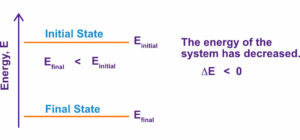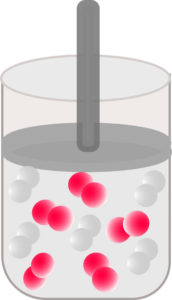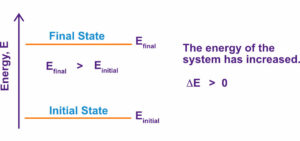System and the Surroundings
When energy is transferred from one object to another, it appears as heat and/or work. We need to define our system, the part of the universe we are focusing on, and the surroundings, everything else (once our system is defined). We define the internal energy, E, of a system as the sum of potential energy and kinetic energy of the system. In a chemical reaction, there is a change in the internal energy of the system:
The change in the energy of a system is accompanied by an equal and opposite change in the energy of the surroundings. For example, if we are studying an aqueous chemical reaction, the reaction (the reactants and products) is the system and the surroundings is the solution, the reaction vessel, and everything else beyond.
A system can be described as open, closed, or isolated. In an open system, both matter and energy can be exchanged with the surroundings. An uncovered pan of boiling water on the stove is an example of an open system. Heat goes into the system from the stove, and water vapor is released from the system to the surroundings. An isolated system is one where neither matter or energy can be exchanged with the surroundings. An example that closely mimics an isolated system would be an ice chest. As long as the lid is kept closed, there is no interaction of the ice and contents of the cooler with the surroundings. The ice will eventually melt and the contents will warm up meaning this system is not a perfectly isolated system.
The most common type of system studied in thermochemistry is a closed system. There is no exchange of matter with the surroundings, but there is an exchange of energy with the surroundings. An example would be that of hydrogen gas and oxygen gas molecules in a vessel outfitted with a piston. The system is the H2 and the O2 gases. The surroundings are the vessel, the piston, and everything else. The reaction is:
Energy is released as the reaction proceeds to form gaseous hydrogen iodide. As the reaction proceeds, energy is transferred from the system to the surroundings. The mass remains the same, and it is only the form of the hydrogen and iodine molecules that changes. No mass is exchanged with the surroundings.
A change in the energy of a system is accompanied by an equal and opposite change in the energy of the surroundings. A system can release energy into the surroundings or a system can absorb energy from the surroundings. If a system releases energy into the surroundings, the energy, E, of the system decreases, ΔE < 0. This is because the energy change, ΔE is equal to the final energy minus the initial energy.
In the figure below, the final energy of the system is less than the initial energy and ΔE < 0. The system has transferred energy to the surroundings resulting in a lower final energy of the system.

In the following figure, the final energy of the system is greater than the initial energy and ΔE > 0. The system has absorbed heat from the surroundings resulting in a higher final energy of the system.
In summary, the internal energy of a system will increase when energy is transferred from the surroundings to the system. The internal energy of a system will decrease when the system transfers energy to the surroundings.
Worksheet: Energy, Heat, and Work
Exercises
Back to Thermochemistry
Back to General Chemistry 1 Study Guides
Back to Home Page


